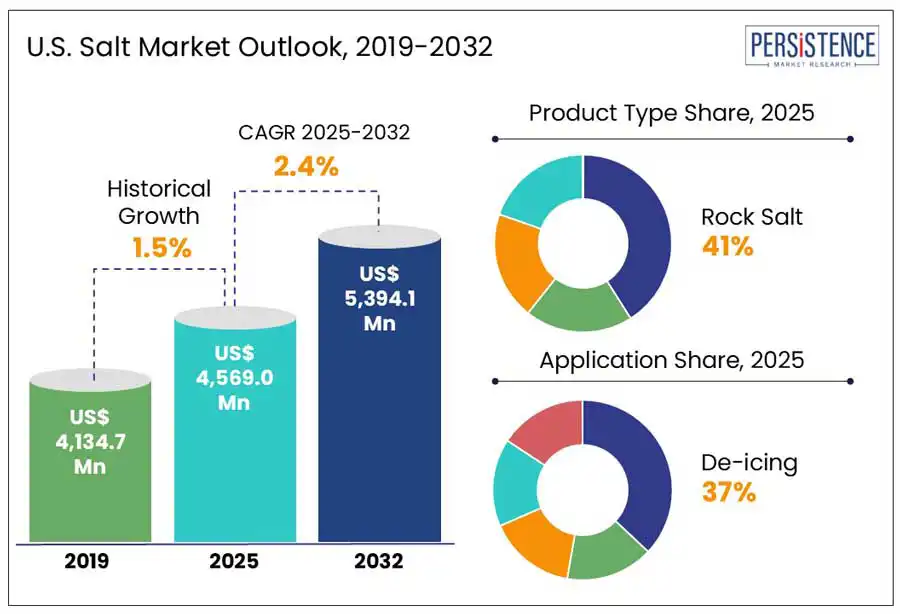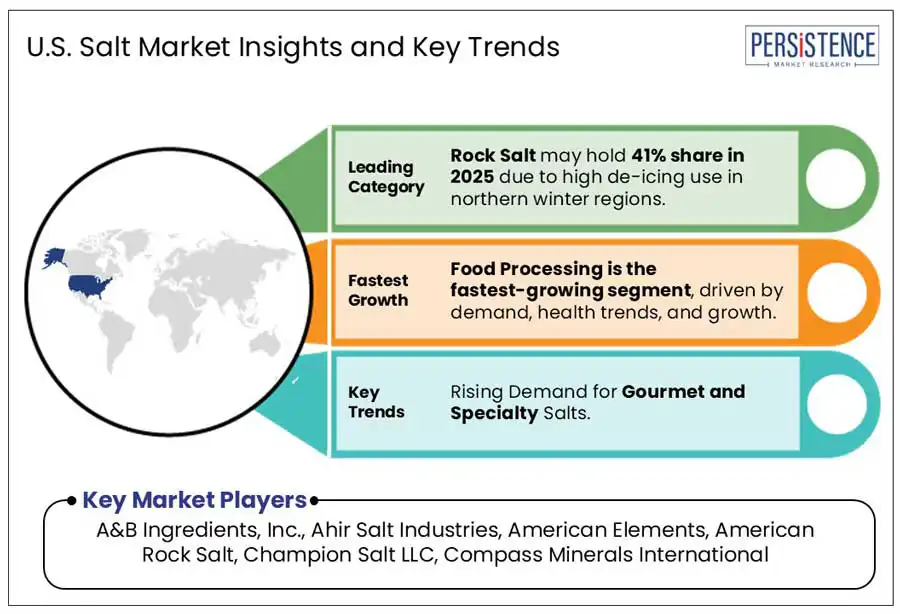ID: PMRREP33163| 142 Pages | 12 May 2025 | Format: PDF, Excel, PPT* | Food and Beverages

The U.S. salt market size is anticipated to reach a value of US$ 4,569.0 Mn in 2025 and is set to attain a value of US$ 5,394.1 Mn to witness a CAGR of 2.4% by 2032. The U.S. salt market is witnessing key trends across various sectors. Gourmet and specialty salts are gaining traction, driven by health-conscious consumers seeking natural and mineral-rich options. Demand in industrial and chemical applications, such as chlor-alkali production, de-icing, and water treatment, remains strong, particularly in Asia Pacific and the Middle-East. Increasing environmental concerns and stricter regulations have pushed the industry toward sustainable practices, including eco-friendly sourcing and innovative packaging. Therefore, these factors are shaping the future of the salt market, emphasizing both quality and sustainability.

Key Industry Highlights:
|
U.S. Market Attribute |
Key Insights |
|
Salt Market Size (2025E) |
US$ 4,569.0 Mn |
|
Market Value Forecast (2032F) |
US$ 5,394.1 Mn |
|
Projected Growth (CAGR 2025 to 2032) |
2.4% |
|
Historical Market Growth (CAGR 2019 to 2024) |
1.5% |
Salt is principally produced using three manufacturing processes: inland brines or seawater solar evaporation, brine mined rock salt, and extraction through solution mining. Furthermore, the momentous growth of the salt-based industry in the U.S has resulted in the growth of industrial salt production through the solar evaporation process.
Owing to the availability of longer coastlines and salty lakes, salt manufacturers in the U.S. are producing salt by utilizing the solar evaporation process. Solar evaporation’s reasonable cost and easy processing further drive the acceptance of this method by various manufacturers/producers in the U.S. industrial salt market. For instance, in January 2022, the United Salt Corporation secured certified renewable Texas wind and solar resources from TXU Energy to cover its energy usage for manufacturing salts.
Excessive sodium intake is a significant public health concern in the United States, impacting the salt market, particularly in food processing applications. The Centers for Disease Control and Prevention (CDC) reports that Americans consume an average of over 3,300 mg of sodium daily, exceeding the recommended limit of 2,300 mg. This overconsumption is linked to increased risks of hypertension, heart disease, and stroke, which are leading causes of death in the country.
In response, public health initiatives are advocating for reduced sodium levels in processed foods, leading manufacturers to reformulate products with lower salt content. This shift is influencing consumer preferences and regulatory standards, thereby restraining growth in the traditional salt market.
The U.S. food and beverage market is rapidly expanding with increase in demand for processed foods driving growth. Salt, used for flavor, preservation, and other functions, is seeing heightened demand. According to the USDA, the processed food sector generates significant revenue, boosting the need for food-grade ingredients such as salt. Vacuum salt, favored for its purity and consistency, is widely used in food processing. As applications for food-grade salt expand globally, the U.S. vacuum salt market is expected to grow significantly over the forecast period driven by its role in the processed food and beverage industry.
Rock salt dominates the U.S. salt market mainly due to its widespread use in road de-icing and strong domestic availability. According to the U.S. Geological Survey, rock salt accounted for about 44% of salt sold or used, and highway de-icing made up about 42% of total salt consumption in 2021. Its low cost, ease of application, and efficiency in melting ice further support its leadership. Significant underground deposits in states such as New York ensure a consistent supply. These factors make rock salt the leading product type in the U.S. salt market.
De-icing leads the U.S. salt market due to its critical role in winter road safety. Annually, approximately 25 million tons of salt are applied to roads across the U.S. to combat snow and ice, ensuring safer travel conditions during winter months. This high usage stems from salt’s effectiveness in lowering the freezing point of water, helping to prevent ice formation. Its affordability and ease of application make it a practical choice for municipalities. With abundant halite deposits in states such as New York and Ohio, supply remains steady. Despite environmental concerns, de-icing continues to dominate salt application across the country.

The U.S. salt market features established players and emerging brands, fostering intense competition. Key strategies include product innovation, geographic expansion, and strategic partnerships. Companies focus on developing novel flavors and healthier options to gain market share. Competition is also driven by pricing, marketing, and distribution efficiencies.
The U.S. market is estimated to increase from US$ 4,569.0 Mn in 2025 to US$ 5,394.1 Mn in 2032.
The U.S. market is driven by the rise in processed food demand, chemical industry growth, and road de-icing needs drive market expansion.
The market is projected to record a CAGR of 2.4% during the forecast period from 2025 to 2032.
The rising demand for food-grade salt, growth in pharmaceutical applications, and innovations in eco-friendly de-icing solutions sum up as potential opportunities.
Major players include A&B Ingredients, Inc., Ahir Salt Industries, American Elements, American Rock Salt, Champion Salt LLC, Compass Minerals International and Others.
|
Report Attribute |
Details |
|
Historical Data/Actuals |
2019 - 2024 |
|
Forecast Period |
2025 - 2032 |
|
Market Analysis Units |
Value: US$ Mn, Volume: As applicable |
|
Competitive Analysis |
|
|
Report Highlights |
|
|
Customization and Pricing |
Available upon request |
By Product Type
By Purity Type
By Application
By Distribution Channel
By Region
Delivery Timelines
For more information on this report and its delivery timelines please get in touch with our sales team.
About Author